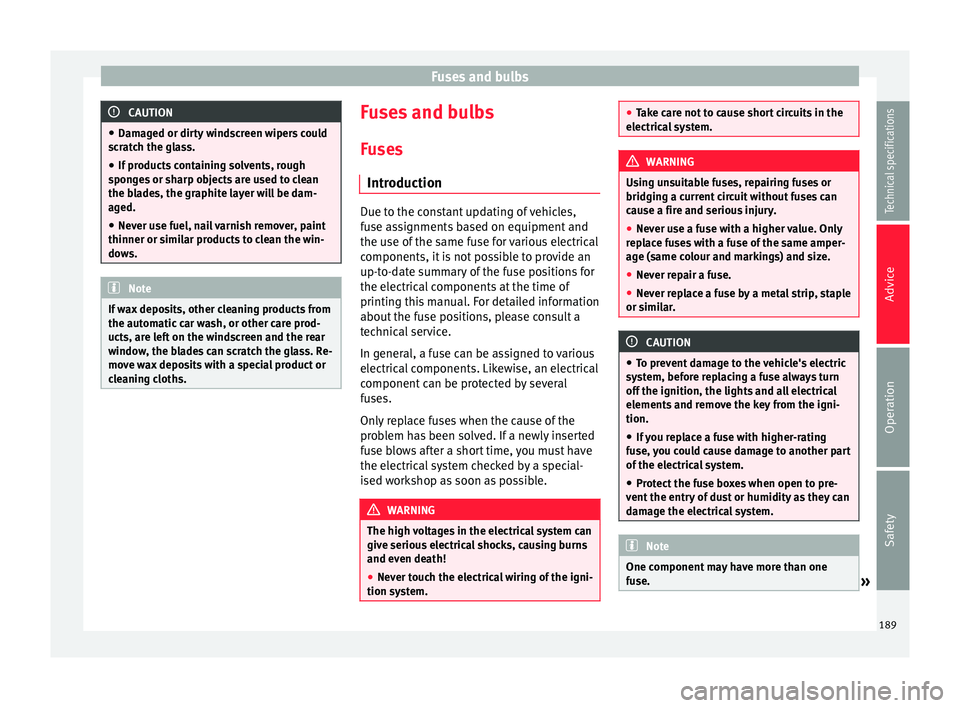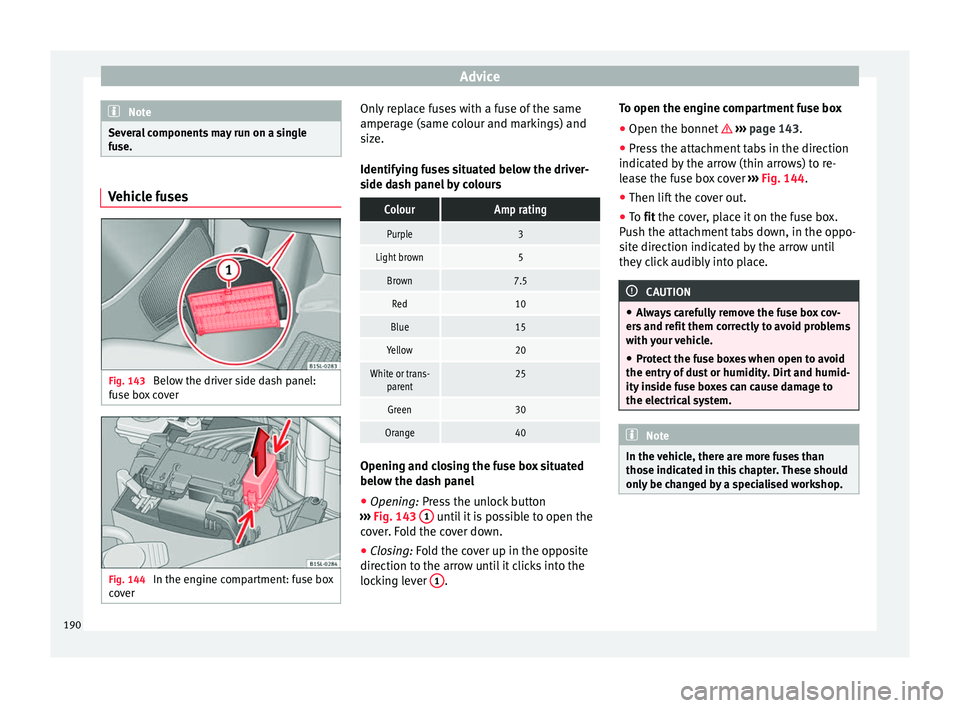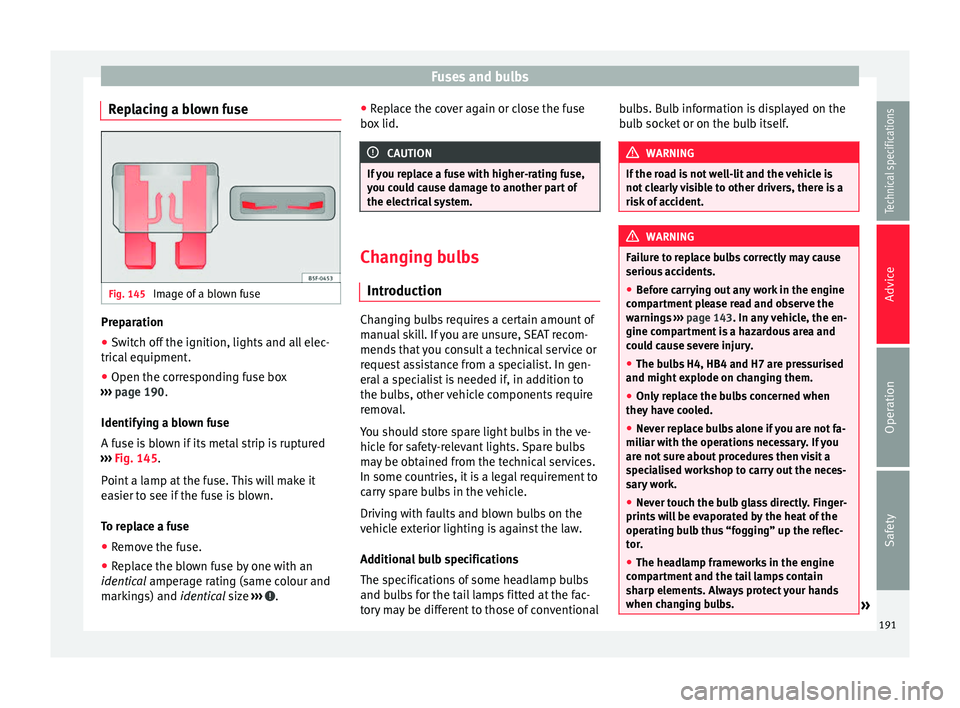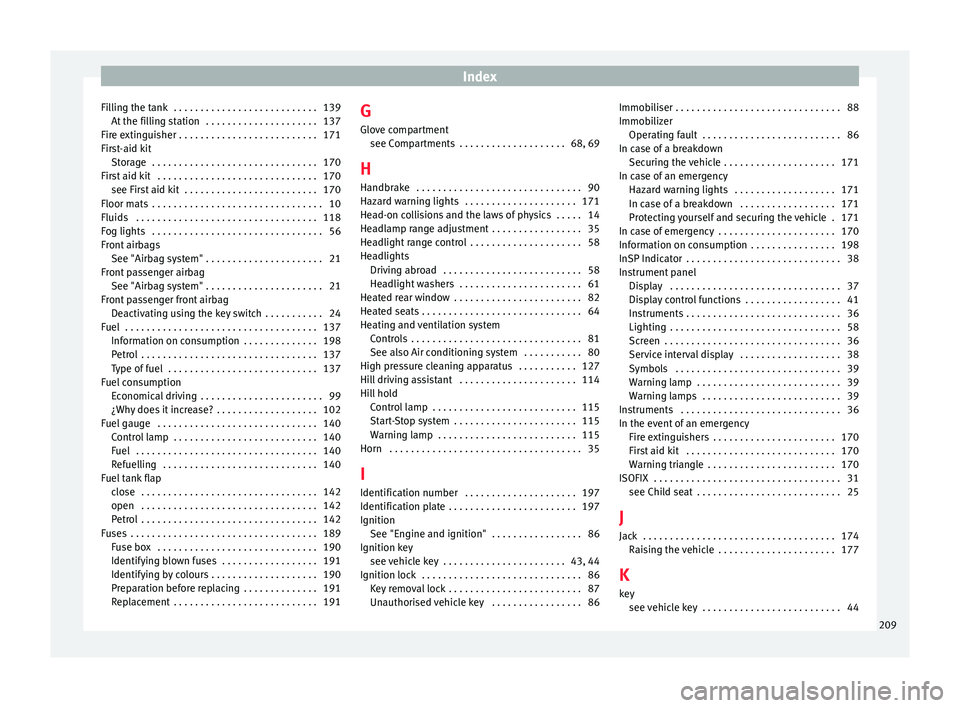fuse box Seat Mii 2014 Owner's manual
[x] Cancel search | Manufacturer: SEAT, Model Year: 2014, Model line: Mii, Model: Seat Mii 2014Pages: 219, PDF Size: 4.19 MB
Page 191 of 219

Fuses and bulbs
CAUTION
● Damaged or dirty windscreen wipers could
scratch the glass.
● If products containing solvents, rough
sponges or sharp objects are used to clean
the blades, the graphite layer will be dam-
aged.
● Never use fuel, nail varnish remover, paint
thinner or similar products to clean the win-
dows. Note
If wax deposits, other cleaning products from
the automatic car wash, or other care prod-
ucts, are left on the windscreen and the rear
window, the blades can scratch the glass. Re-
move wax deposits with a special product or
cleaning cloths. Fuses and bulbs
Fuses Introduction Due to the constant updating of vehicles,
fuse assignments based on equipment and
the use of the same fuse for various electrical
components, it is not possible to provide an
up-to-date summary of the fuse positions for
the electrical components at the time of
printing this manual. For detailed information
about the fuse positions, please consult a
technical service.
In general, a fuse can be assigned to various
electrical components. Likewise, an electrical
component can be protected by several
fuses.
Only replace fuses when the cause of the
problem has been solved. If a newly inserted
fuse blows after a short time, you must have
the electrical system checked by a special-
ised workshop as soon as possible.
WARNING
The high voltages in the electrical system can
give serious electrical shocks, causing burns
and even death!
● Never touch the electrical wiring of the igni-
tion system. ●
Take care not to cause short circuits in the
electrical system. WARNING
Using unsuitable fuses, repairing fuses or
bridging a current circuit without fuses can
cause a fire and serious injury.
● Never use a fuse with a higher value. Only
replace fuses with a fuse of the same amper-
age (same colour and markings) and size.
● Never repair a fuse.
● Never replace a fuse by a metal strip, staple
or similar. CAUTION
● To prevent damage to the vehicle's electric
system, before replacing a fuse always turn
off the ignition, the lights and all electrical
elements and remove the key from the igni-
tion.
● If you replace a fuse with higher-rating
fuse, you could cause damage to another part
of the electrical system.
● Protect the fuse boxes when open to pre-
vent the entry of dust or humidity as they can
damage the electrical system. Note
One component may have more than one
fuse. » 189Technical specifications
Advice
Operation
Safety
Page 192 of 219

Advice
Note
Several components may run on a single
fuse. Vehicle fuses
Fig. 143
Below the driver side dash panel:
fuse box cover Fig. 144
In the engine compartment: fuse box
cover Only replace fuses with a fuse of the same
amperage (same colour and markings) and
size.
Identifying fuses situated below the driver-
side dash panel by coloursColourAmp rating
Purple3
Light brown5
Brown7.5
Red10
Blue15
Yellow20
White or trans-
parent25
Green30
Orange40 Opening and closing the fuse box situated
below the dash panel
●
Opening: Press the unlock button
› ›
› Fig. 143 1 until it is possible to open the
cover. Fold the cover down.
● Closing: Fold the cover up in the opposite
dir ection t
o the arrow until it clicks into the
locking lever 1 .To open the engine compartment fuse box
●
Open the bonnet ››› page 143.
● Press the attachment tabs in the direction
indicated by the arrow (thin arrows) to re-
lease the fuse box cover ››› Fig. 144 .
● Then lif t
the cover out.
● To fit the cover, place it on the fuse box.
P
ush the attachment tabs down, in the oppo-
site direction indicated by the arrow until
they click audibly into place. CAUTION
● Always carefully remove the fuse box cov-
ers and refit them correctly to avoid problems
with your vehicle.
● Protect the fuse boxes when open to avoid
the entry of dust or humidity. Dirt and humid-
ity inside fuse boxes can cause damage to
the electrical system. Note
In the vehicle, there are more fuses than
those indicated in this chapter. These should
only be changed by a specialised workshop. 190
Page 193 of 219

Fuses and bulbs
Replacing a blown fuse Fig. 145
Image of a blown fuse Preparation
● Switch off the ignition, lights and all elec-
trical equipment.
● Open the corresponding fuse box
››› page 190 .
Identif y
ing a blown fuse
A fuse is blown if its metal strip is ruptured
››› Fig. 145.
Point a lamp at the fuse. This will make it
easier to see if the fuse is blown.
To replace a fuse ● Remove the fuse.
● Replace the blown fuse by one with an
identical amperage rating (same colour and
mark
ings) and identical size ››› .●
Replace the cover again or close the fuse
box lid. CAUTION
If you replace a fuse with higher-rating fuse,
you could cause damage to another part of
the electrical system. Changing bulbs
Introduction Changing bulbs requires a certain amount of
manual skill. If you are unsure, SEAT recom-
mends that you consult a technical service or
request assistance from a specialist. In gen-
eral a specialist is needed if, in addition to
the bulbs, other vehicle components require
removal.
You should store spare light bulbs in the ve-
hicle for safety-relevant lights. Spare bulbs
may be obtained from the technical services.
In some countries, it is a legal requirement to
carry spare bulbs in the vehicle.
Driving with faults and blown bulbs on the
vehicle exterior lighting is against the law.
Additional bulb specifications
The specifications of some headlamp bulbs
and bulbs for the tail lamps fitted at the fac-
tory may be different to those of conventionalbulbs. Bulb information is displayed on the
bulb socket or on the bulb itself.
WARNING
If the road is not well-lit and the vehicle is
not clearly visible to other drivers, there is a
risk of accident. WARNING
Failure to replace bulbs correctly may cause
serious accidents.
● Before carrying out any work in the engine
compartment please read and observe the
warnings ››› page 143. In any vehicle, the en-
gine c omp
artment is a hazardous area and
could cause severe injury.
● The bulbs H4, HB4 and H7 are pressurised
and might explode on changing them.
● Only replace the bulbs concerned when
they have cooled.
● Never replace bulbs alone if you are not fa-
miliar with the operations necessary. If you
are not sure about procedures then visit a
specialised workshop to carry out the neces-
sary work.
● Never touch the bulb glass directly. Finger-
prints will be evaporated by the heat of the
operating bulb thus “fogging” up the reflec-
tor.
● The headlamp frameworks in the engine
compartment and the tail lamps contain
sharp elements. Always protect your hands
when changing bulbs. » 191
Technical specifications
Advice
Operation
Safety
Page 211 of 219

Index
Filling the tank . . . . . . . . . . . . . . . . . . . . . . . . . . . 139 At the filling station . . . . . . . . . . . . . . . . . . . . . 137
Fire extinguisher . . . . . . . . . . . . . . . . . . . . . . . . . . 171
First-aid kit Storage . . . . . . . . . . . . . . . . . . . . . . . . . . . . . . . 170
First aid kit . . . . . . . . . . . . . . . . . . . . . . . . . . . . . . 170 see First aid kit . . . . . . . . . . . . . . . . . . . . . . . . . 170
Floor mats . . . . . . . . . . . . . . . . . . . . . . . . . . . . . . . . 10
Fluids . . . . . . . . . . . . . . . . . . . . . . . . . . . . . . . . . . 118
Fog lights . . . . . . . . . . . . . . . . . . . . . . . . . . . . . . . . 56
Front airbags See "Airbag system" . . . . . . . . . . . . . . . . . . . . . . 21
Front passenger airbag See "Airbag system" . . . . . . . . . . . . . . . . . . . . . . 21
Front passenger front airbag Deactivating using the key switch . . . . . . . . . . . 24
Fuel . . . . . . . . . . . . . . . . . . . . . . . . . . . . . . . . . . . . 137 Information on consumption . . . . . . . . . . . . . . 198
Petrol . . . . . . . . . . . . . . . . . . . . . . . . . . . . . . . . . 137
Type of fuel . . . . . . . . . . . . . . . . . . . . . . . . . . . . 137
Fuel consumption Economical driving . . . . . . . . . . . . . . . . . . . . . . . 99
¿Why does it increase? . . . . . . . . . . . . . . . . . . . 102
Fuel gauge . . . . . . . . . . . . . . . . . . . . . . . . . . . . . . 140 Control lamp . . . . . . . . . . . . . . . . . . . . . . . . . . . 140
Fuel . . . . . . . . . . . . . . . . . . . . . . . . . . . . . . . . . . 140
Refuelling . . . . . . . . . . . . . . . . . . . . . . . . . . . . . 140
Fuel tank flap close . . . . . . . . . . . . . . . . . . . . . . . . . . . . . . . . . 142
open . . . . . . . . . . . . . . . . . . . . . . . . . . . . . . . . . 142
Petrol . . . . . . . . . . . . . . . . . . . . . . . . . . . . . . . . . 142
Fuses . . . . . . . . . . . . . . . . . . . . . . . . . . . . . . . . . . . 189 Fuse box . . . . . . . . . . . . . . . . . . . . . . . . . . . . . . 190
Identifying blown fuses . . . . . . . . . . . . . . . . . . 191
Identifying by colours . . . . . . . . . . . . . . . . . . . . 190
Preparation before replacing . . . . . . . . . . . . . . 191
Replacement . . . . . . . . . . . . . . . . . . . . . . . . . . . 191 G
Glove compartment
see Compartments . . . . . . . . . . . . . . . . . . . . 68, 69
H Handbrake . . . . . . . . . . . . . . . . . . . . . . . . . . . . . . . 90
Hazard warning lights . . . . . . . . . . . . . . . . . . . . . 171
Head-on collisions and the laws of physics . . . . . 14
Headlamp range adjustment . . . . . . . . . . . . . . . . . 35
Headlight range control . . . . . . . . . . . . . . . . . . . . . 58
Headlights Driving abroad . . . . . . . . . . . . . . . . . . . . . . . . . . 58
Headlight washers . . . . . . . . . . . . . . . . . . . . . . . 61
Heated rear window . . . . . . . . . . . . . . . . . . . . . . . . 82
Heated seats . . . . . . . . . . . . . . . . . . . . . . . . . . . . . . 64
Heating and ventilation system Controls . . . . . . . . . . . . . . . . . . . . . . . . . . . . . . . . 81
See also Air conditioning system . . . . . . . . . . . 80
High pressure cleaning apparatus . . . . . . . . . . . 127
Hill driving assistant . . . . . . . . . . . . . . . . . . . . . . 114
Hill hold Control lamp . . . . . . . . . . . . . . . . . . . . . . . . . . . 115
Start-Stop system . . . . . . . . . . . . . . . . . . . . . . . 115
Warning lamp . . . . . . . . . . . . . . . . . . . . . . . . . . 115
Horn . . . . . . . . . . . . . . . . . . . . . . . . . . . . . . . . . . . . 35
I Identification number . . . . . . . . . . . . . . . . . . . . . 197
Identification plate . . . . . . . . . . . . . . . . . . . . . . . . 197
Ignition See "Engine and ignition" . . . . . . . . . . . . . . . . . 86
Ignition key see vehicle key . . . . . . . . . . . . . . . . . . . . . . . 43, 44
Ignition lock . . . . . . . . . . . . . . . . . . . . . . . . . . . . . . 86 Key removal lock . . . . . . . . . . . . . . . . . . . . . . . . . 87
Unauthorised vehicle key . . . . . . . . . . . . . . . . . 86 Immobiliser . . . . . . . . . . . . . . . . . . . . . . . . . . . . . . . 88
Immobilizer
Operating fault . . . . . . . . . . . . . . . . . . . . . . . . . . 86
In case of a breakdown Securing the vehicle . . . . . . . . . . . . . . . . . . . . . 171
In case of an emergency Hazard warning lights . . . . . . . . . . . . . . . . . . . 171
In case of a breakdown . . . . . . . . . . . . . . . . . . 171
Protecting yourself and securing the vehicle . 171
In case of emergency . . . . . . . . . . . . . . . . . . . . . . 170
Information on consumption . . . . . . . . . . . . . . . . 198
InSP Indicator . . . . . . . . . . . . . . . . . . . . . . . . . . . . . 38
Instrument panel Display . . . . . . . . . . . . . . . . . . . . . . . . . . . . . . . . 37
Display control functions . . . . . . . . . . . . . . . . . . 41
Instruments . . . . . . . . . . . . . . . . . . . . . . . . . . . . . 36
Lighting . . . . . . . . . . . . . . . . . . . . . . . . . . . . . . . . 58
Screen . . . . . . . . . . . . . . . . . . . . . . . . . . . . . . . . . 36
Service interval display . . . . . . . . . . . . . . . . . . . 38
Symbols . . . . . . . . . . . . . . . . . . . . . . . . . . . . . . . 39
Warning lamp . . . . . . . . . . . . . . . . . . . . . . . . . . . 39
Warning lamps . . . . . . . . . . . . . . . . . . . . . . . . . . 39
Instruments . . . . . . . . . . . . . . . . . . . . . . . . . . . . . . 36
In the event of an emergency Fire extinguishers . . . . . . . . . . . . . . . . . . . . . . . 170
First aid kit . . . . . . . . . . . . . . . . . . . . . . . . . . . . 170
Warning triangle . . . . . . . . . . . . . . . . . . . . . . . . 170
ISOFIX . . . . . . . . . . . . . . . . . . . . . . . . . . . . . . . . . . . 31 see Child seat . . . . . . . . . . . . . . . . . . . . . . . . . . . 25
J Jack . . . . . . . . . . . . . . . . . . . . . . . . . . . . . . . . . . . . 174 Raising the vehicle . . . . . . . . . . . . . . . . . . . . . . 177
K key see vehicle key . . . . . . . . . . . . . . . . . . . . . . . . . . 44
209